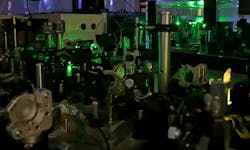Quantum light can ‘see’ quantum sound within molecules
University of East Anglia (UEA; Norwich, U.K.) researchers are applying techniques from quantum optics, which explores the quantum nature of light and its interactions with matter at the atomic scale, to unveil quantum effects within molecular systems (see video).
The inspiration for this work hit when Garth Jones, an associate professor of theoretical chemistry, and Magnus Borgh, an associate professor of physics, realized they could apply methods from quantum optics to molecules to explore whether certain processes are essentially classical or quantum in nature.
Quantum optics often works with pristine atomic systems. Chemists, on the other hand, work with molecules much more complex than atoms, which also tend to exist within a solution.
“We wanted to understand how vibrations within the molecule—and their escape as sound within the environment—affect its interaction with light,” explains Borgh. “Do quantum effects survive or does the interaction become essentially classical?”
Answers to fundamental quantum questions
Finding an answer can provide a path toward answering longstanding, fundamental, and still unanswered questions regarding the role quantum mechanics plays when energy from light is transferred within molecules, such as in photosynthesis.
So the team built a simpler theoretical model similar to spectroscopic experiments: A molecule within an environment is driven by a laser and the molecule itself emits light as it moves between quantum-mechanical energy levels. And it gets even better: the molecule is also vibrating, and these vibrations are quantized.
“Just as quanta of light are called photons—a phenomenon that decades ago provided the first direct evidence of the quantum nature of light—and can relatively readily be measured, we show that not only do the familiar quantum-mechanical signatures survive but there are also signatures that appear as a direct consequence of the phonons, the quantum sound,” says Borgh.
The biggest surprise for Borgh and colleagues came when they realized they could treat phonons with the same methods as photons to directly understand that signatures calculated in the measurable photon correlations corresponded directly to the unmeasurable dynamics of individual phonons. “Suddenly, the results Ben Humphries, a Ph.D. student in theoretical chemistry, was painstakingly computing using sophisticated theoretical-chemistry methods on UEA’s computer cluster made perfect sense,” Borgh says.
This project builds on a very technical idea and “the biggest challenge was to really understand what the results of our computations were telling us,” says Borgh. “This is where our project really needed the collaboration between theoretical chemistry and quantum optics.”
While this is a fantastic example of fundamental research with an objective to understand how nature works, it doesn’t mean there aren’t applications. The most immediate ones are likely to be further academic research. “We hope our results can form the inspiration and basis for experiments to help us understand the inner workings of molecules interacting with light,” Borgh says. “In the long run, it could find applications in quantum technologies.”
The researchers’ work shows a fundamental result “in a simplified—but still very complicated—system,” says Borgh. “Now, we want to take our work further to understand molecular models that may come closer to an actual experiment.”
FURTHER READING
B. S. Humphries, D. Green, M. O. Borgh, and G. A. Jones, Phys. Rev. Lett., 131, 143601 (Oct. 2, 2023); https://doi.org/10.1103/physrevlett.131.143601.
About the Author
Sally Cole Johnson
Editor in Chief
Sally Cole Johnson, Laser Focus World’s editor in chief, is a science and technology journalist who specializes in physics and semiconductors.

